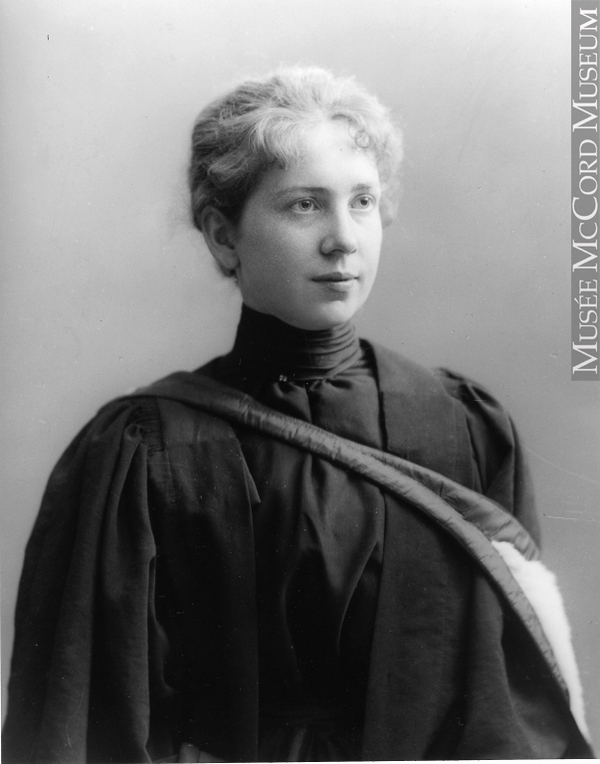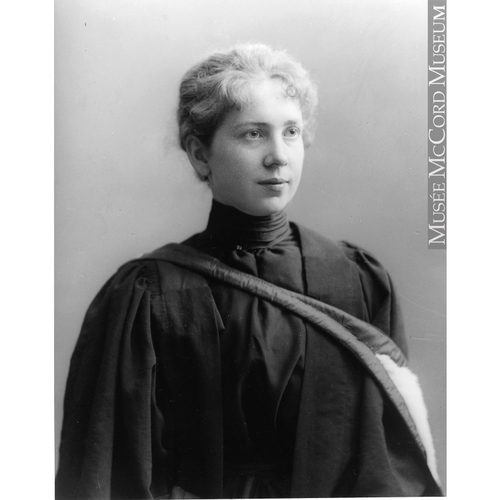
Source: Link
BROOKS, HARRIET (she signed two publications H. T. Brooks) (Pitcher), teacher and nuclear physicist; b. 2 July 1876 in Exeter, Ont., daughter of George Brooks, a commercial traveller, and Elizabeth Agnes Worden; m. 13 July 1907 Frank Henry Pitcher, a civil engineer, in London, England, and they had two sons and one daughter; d. 17 April 1933 in Montreal.
The third of nine children, Harriet Brooks moved with her family around Ontario and Quebec during her youth. At some point she attended the Seaforth Collegiate Institute in Ontario. Her parents finally settled in Montreal, and her mother encouraged Harriet and her sisters to continue their education. Harriet entered McGill University in 1894; her program focused mainly on physics. Academic success brought her prizes and scholarships that enabled her to continue her studies. In 1898 she obtained a ba with first-class honours in mathematics and natural philosophy, and she was awarded the Anne Molson Gold Medal for outstanding performance in mathematics.
After graduation, Brooks was invited to join the research group of Professor Ernest Rutherford who had just arrived from the Cavendish Laboratory at the University of Cambridge, having been lured across the Atlantic by the attraction of the new Macdonald Physics Building at McGill designed by Andrew Thomas Taylor. For her ma thesis, Brooks undertook research in the field of electricity and magnetism. In 1901 she received the first master’s degree awarded to a woman in physics at McGill. While completing her studies, she had taught at the Royal Victoria College, McGill’s institution for women.
In 1900 Brooks commenced work that went in a new direction: the study of the emanation given off by radioactive substances such as thorium. At the time, this material was variously believed to be a gas, a vapour, or a fine powder. Brooks showed that the material was, in fact, a gas, of significantly lower molecular weight than thorium. Thus, it could not be simply a gaseous form of the same element. Her discovery led Rutherford and chemistry instructor Frederick Soddy to realize that one element had transmuted into another. Brooks was the first person to characterize the gas, now known as radon.
Brooks obtained a fellowship in 1901 to study for a doctorate in physics at Bryn Mawr College in Pennsylvania. At that time, Bryn Mawr possessed the fourth largest graduate school for women in the United States. During her year there Brooks was awarded the prestigious Bryn Mawr European Fellowship, which she elected to take at Cambridge in the laboratory of Joseph John Thomson. Although her research on the radiations from radium and thorium went well, she was without a mentor (a role Rutherford had played at McGill); her self-esteem diminished, and she became convinced that her scientific abilities were insufficient to allow her to continue on towards a phd. She returned to McGill to resume her research with Rutherford and her teaching at Royal Victoria College.
Brooks’s next crucial discovery was that radioactivity could be transferred from one surface to another. The phenomenon was later determined to be caused by the recoil of the radioactive atom’s nucleus; that is, when a particle is expelled from a nucleus, the nucleus recoils in the opposite direction, sometimes with enough energy to escape from its location and become embedded on another surface. The recoil effect was used by later researchers such as Otto Hahn and Lise Meitner to separate previously unknown daughter elements in radioactive-decay sequences. The third of Brooks’s findings was that there are sequential releases of radiation when uranium and thorium decay. This information was the centrepiece of Rutherford’s Bakerian Lecture of 1904 before the Royal Society of London, when he expounded on the successive transformations of the heavy radioactive elements during the process of decay. In his presentation he gave due credit to Brooks’s contributions.
In 1904 Brooks again left McGill. She accepted an appointment as tutor in physics at Barnard College, a women’s institution associated with Columbia College in New York City. In July 1906 she announced her engagement to Bergen Davis, a professor of physics at Columbia. The dean at Barnard, Laura Drake Gill, believed that a woman could not simultaneously fulfil marital and academic duties, and demanded her resignation. In a private letter to the dean, Brooks wrote a spirited defence, but the issue became irrelevant when she broke off the engagement. She had decided to leave Barnard anyway, and that year she moved to a retreat in the Adirondack Mountains run by Fabian socialists John Martin and his wife, Prestonia Mann Martin. Among their other guests were Russian author Maksim Gorky and members of his entourage. Brooks may have met the Martins after a talk given at Barnard by Gorky’s common-law wife, Mariya Fyodorovna Andreyeva, who was their guest. Brooks travelled with the Gorky party from New York to Capri, Italy. After a brief sojourn there, she left for Paris where she undertook research with Marie Curie at the Institut du Radium.
Early in 1907 Rutherford took up a post at the Victoria University of Manchester in England, and he offered Brooks a prestigious fellowship so that she could rejoin his research group. Brooks resigned her position in Paris, but she then wrote to Rutherford informing him that she was engaged and that she declined the fellowship. The suitor was her former undergraduate laboratory instructor at McGill, Frank Pitcher, who for the previous six months had been sending her letters declaring his romantic interest. The marriage took place in England; the couple moved back to Montreal, where Harriet Pitcher assumed the occupations of wife and mother. She had doubted that she could find long-term employment in physics research, and after Rutherford’s departure, work on radiation at McGill had soon ceased. In addition, her two closest friends, Prestonia Martin and Rutherford’s wife, Mary Georgina, held traditional views on women’s role. Although Pitcher did not continue in physics, she was a charter member of the University Women’s Club of Montreal. In 1907 she joined the Women’s Canadian Club; she would serve as honorary secretary in 1909–10 and 1911–12, and as president in 1923. Active in the Alumnae Society of McGill University, in 1910 she gave a presentation to its members on the work of Marie Curie. She died at age 56, probably as a result of her exposure to radiation. She was inducted into the Canadian Science and Engineering Hall of Fame in 2002.
This biography is based on the authors’ book Harriet Brooks: pioneer nuclear scientist (Montreal and Kingston, Ont., 1992). Brooks is the author of “Damping of electrical oscillations,” RSC, Trans., 2nd ser., 5 (1899), sect.iii: 13–15; “A volatile product from radium,” Nature (London), 21 July 1904: 270; and “The decay of the excited radioactivity from thorium, radium, and actinium,” London, Edinburgh, and Dublin Philosophical Magazine and Journal of Science (London), 6th ser., 8 (1904): 373–74. Together with Ernest Rutherford, she published under the name of H. T. Brooks “The new gas from radium,” RSC, Trans., 2nd ser., 7 (1901), sect.iii: 21–25, and “Comparison of the radiations from radioactive substances,” London, Edinburgh, and Dublin Philosophical Magazine and Journal of Science, 6th ser., 4 (1902): 1–23.
Cite This Article
Marelene Rayner-Canham and Geoff Rayner-Canham, “BROOKS, HARRIET (H.T. Brooks) (Pitcher),” in Dictionary of Canadian Biography, vol. 16, University of Toronto/Université Laval, 2003–, accessed December 23, 2025, https://www.biographi.ca/en/bio/brooks_harriet_16E.html.
The citation above shows the format for footnotes and endnotes according to the Chicago manual of style (16th edition). Information to be used in other citation formats:
| Permalink: | https://www.biographi.ca/en/bio/brooks_harriet_16E.html |
| Author of Article: | Marelene Rayner-Canham and Geoff Rayner-Canham |
| Title of Article: | BROOKS, HARRIET (H.T. Brooks) (Pitcher) |
| Publication Name: | Dictionary of Canadian Biography, vol. 16 |
| Publisher: | University of Toronto/Université Laval |
| Year of publication: | 2016 |
| Year of revision: | 2016 |
| Access Date: | December 23, 2025 |



